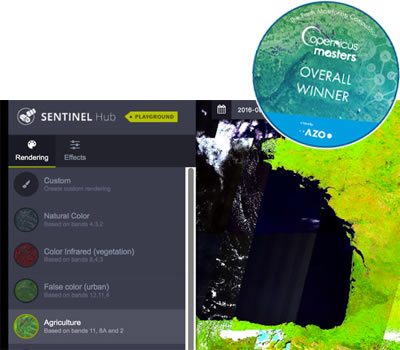Pathbreaking web service wins Copernicus Masters competition
On 25th October 2016, this year's winners in the Earth observation competition Copernicus Masters were recognised by high-ranking industry and institutional representatives before an international audience in Madrid. Taking home the grand prize was the team around Grega Milcinski from Slovenia's Sinergise.
Their Sentinel Hub – a cloud-based web service for satellite data – triumphed in the T-Systems Open Telekom Cloud Challenge before edging out the winners of the other six categories.
Earth observation satellites, including the Sentinels of Europe's Copernicus programme, produce tremendous amounts of data every day. This presents an enormous potential for scientific and commercial applications here on the ground. So far, however, downloading, processing, and storing petabytes of data has posed major challenges to many user groups. Sentinel Hub makes it possible to browse, process, and distribute large amounts of data quickly and efficiently - even for non-expert users. Thanks to its ability to integrate into any GIS or web application, this online service is poised to fundamentally affect the daily work routines of developers, scientists, and many other target groups.

"According to a recent PWC study Copernicus has become the third largest data supplier in the world. Sentinel data access is full, free and open to all users world-wide. Sentinel Hub significantly simplifies the way users can access and process satellite data," explained Dr. Josef Aschbacher, ESA's Director of Earth Observation Programmes, at the awards ceremony in Madrid. "With applications like these, the 2016 Copernicus Masters competition has once again clearly demonstrated its potential to drive the innovative use of Earth observation data and make the Copernicus programme accessible to new user groups."
Copernicus Masters competition
Having received a total of more than 900 ideas from over 70 countries to date, the Copernicus Masters has evolved into the leading international ideas competition for the next generation of Earth observation applications. Since 2011, it has recognised each year's most promising and revolutionary innovations and business concepts. The 70 best applications produced through the Copernicus Masters and its affiliated Space App Camps are now presented in the ESA publication Copernicus in Action, in partnership with AZO.
Prize pool designed to help bring innovations to market
In this year's seven topic-specific challenges, prizes worth a total of EUR 600,000 were sponsored by the Copernicus Masters' prominent partners: the European Space Agency (ESA), the German Aerospace Centre (DLR), T-Systems International GmbH, Satellite Applications Catapult Ltd., the German Federal Ministry of Transport and Digital Infrastructure (BMVI), and Stevenson Astrosat Ltd. The University Challenge, meanwhile, was geared towards students and research assistants.
Along with cash prizes, consulting and data packages, and other benefits, the winners will now have the opportunity to ready their ideas for the marketplace at one of the 16 ESA Business Incubation Centres across Europe. With financial support from the European Commission, the Copernicus Accelerator will also invite 40 Copernicus Masters’ finalists to take part in a tailored eight-months mentoring programme that will help them advance their business ideas.
"We're proud of the fact that we've seen more and more start-ups getting involved in the commercialisation of Earth observation services since the competition's inception in 2011, particular in the ESA BIC programme," declared CEO Thorsten Rudolph from AZO, the organiser of the Copernicus Masters. "Through our initiatives, we've been able to provide support to innovative projects all along the value chain."
The seven best Earth observation applications of 2016
In addition to highlighting the benefits Copernicus offers to a wide array of sectors, the winners of this year's seven Copernicus Masters challenges present further proof of the competition's ability to showcase market-oriented applications of Earth observation data.
University challenge
- SpaceToPlace - EO to Empower UNESCO Site Managers, submitted by Prof Dr Alexander Siegmund and his team from Research Group for Earth Observation (rgeo), Dept. of Geography, Heidelberg University of Education & Heidelberg University, Germany
- ESA App Challenge SnapPlanet - The Social Network for Earth Observation, submitted by Jérôme Gasperi, Jeobrowser, France
- DLR Environment, Energy, and Health Challenge Viridian Raven - Risk Analysis to Prevent Insect Outbreaks, submitted by Wendy Mensink and her team, The Netherlands
- T-Systems Open Telekom Cloud Challenge & Overall Winner Sentinel Hub – A cloud-based web service for satellite imagery, submitted by Grega Milcinski and his team at Sinergise Ltd., Slovenia
- Sustainable Living Challenge by the Satellite Applications Catapult EnviroSAR – Managing Wildfire Disturbance in Moorlands and Heathlands, submitted by Dr. Gail Millin-Chalabi and her team at the University of Manchester, Great Britain
- BMVI Earth Observation Challenge for Digital Transport Applications RETRIEVE - Sentinels for Safe Transportation and Retrieval of High-value Goods, submitted by Hartmut Runge and his team at the German Aerospace Center (DLR), Germany
- Astrosat End-to-End EO Challenge SCAMPER - Safeguarding a EUR Six Billion Global Food Resource from Space, submitted by Bruce Hannah, National Space Centre Ltd., Ireland
Awards Ceremony and Satellite Masters conference held in Madrid
The Satellite Masters Conference has become a must-attend event for industries, scientists, and start-ups involved in the commercial use of Earth observation and satellite navigation. Initiated by AZO, co-organised by madri+d and Comunidad da Madrid and with support from Deloitte, the conference was held for the first time at Madrid's Circulo de Bellas Artes. It thus provided a festive setting for the Copernicus Masters Awards Ceremony, as well: This year's winners had the chance to present their ideas to the international Earth observation and navigation scene and discuss innovations in space-based technologies and services with those in attendance.










